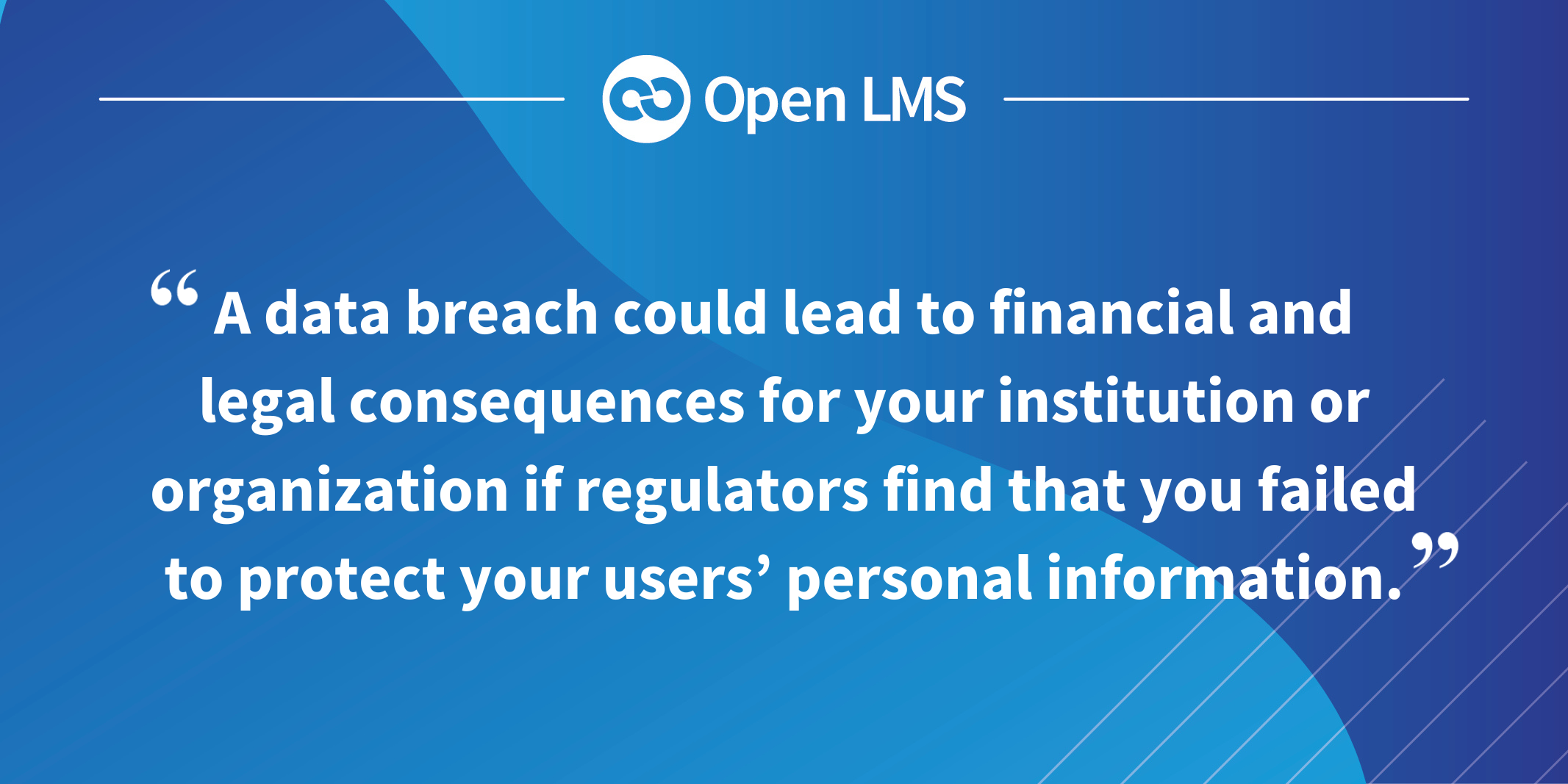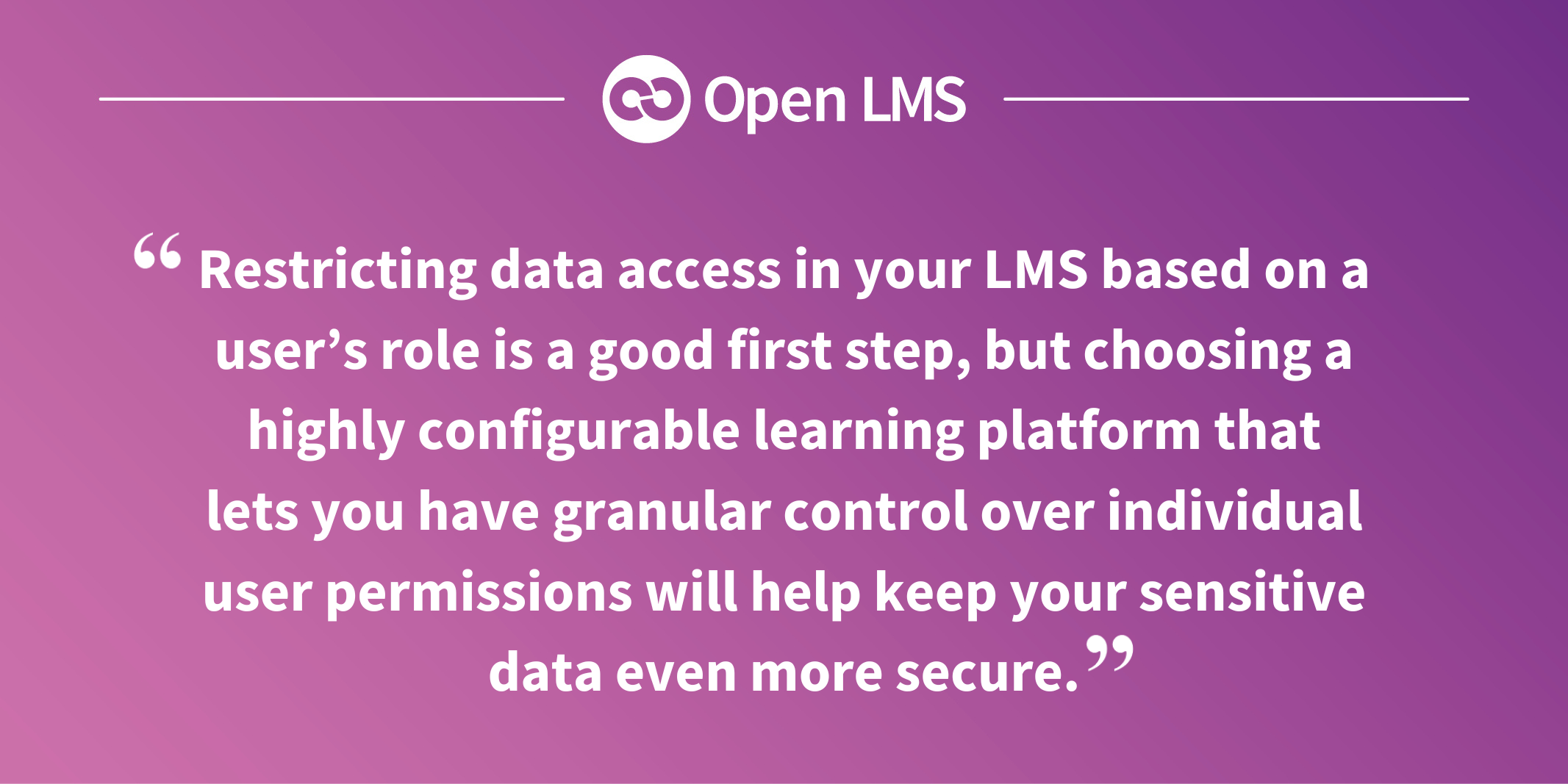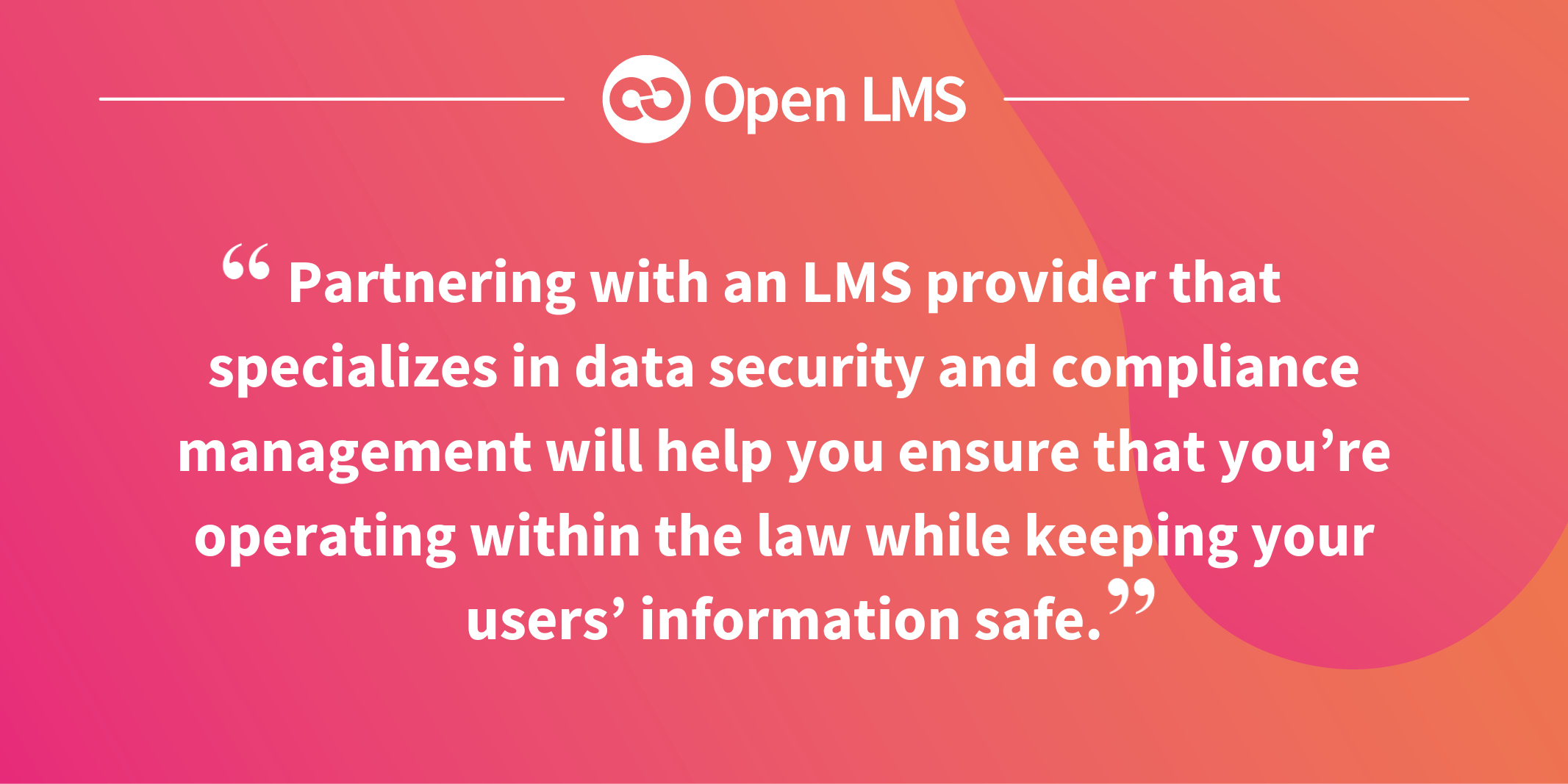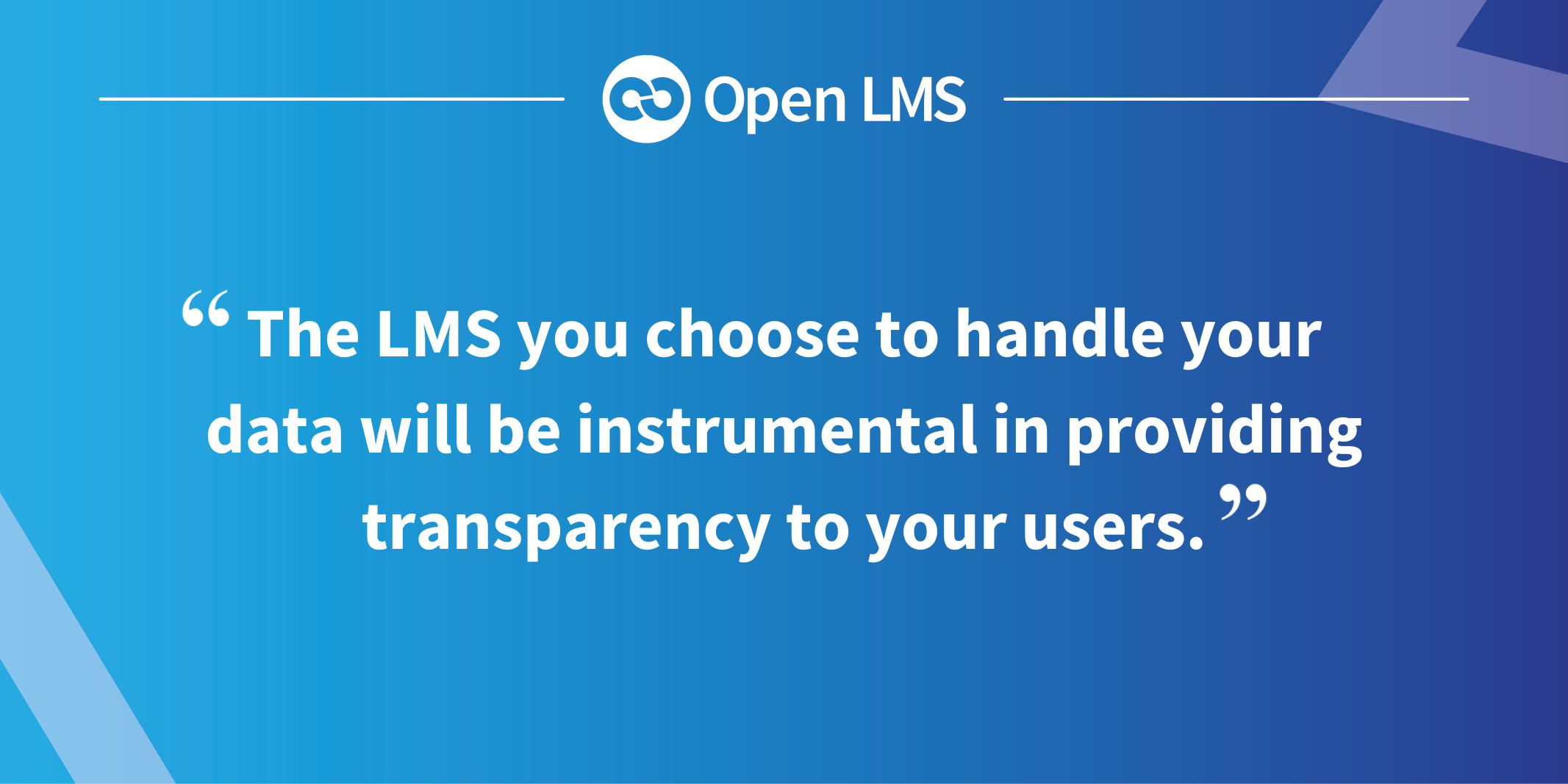Avoid Data Breaches and Penalties: 3 Key Ways to Balance Student and Employee Privacy In Digital Learning
As digital learning becomes more personalized and data-driven, protecting your learners’ privacy has never been more critical. Whether you’re training your workforce or educating students at a college or university, your learning platform captures and stores large volumes of personal information—and it’s your responsibility to protect it! Maintaining privacy isn’t just a best practice; it’s a regulatory requirement and a trust-building imperative.
So how do you balance the need for actionable LMS insights with the responsibility to safeguard learners’ personal information? This blog post explores how learning leaders can approach privacy holistically by securing personal data, maintaining global compliance, and building long-term trust through transparency.
READ MORE ABOUT DATA PRIVACY | ‘How Open LMS’s Rigorous Approach to LMS Plugins Provides Security, Compliance, and Partnership’

What Makes Learning Data So Sensitive?
Organizations and higher education institutions often leverage a learning management system to handle their users’ enrollment information and assessment scores, but an LMS can contain a lot more than basic course information. Your users’ training and learning data includes personally identifiable information (PII), such as your learners’:
- Legal names
- Email addresses
- Birthdates
- Physical locations
Organizations sometimes choose to track their employees’ development using ID numbers or role-specific information instead of their users’ legal names. While this adds a layer of anonymity, ID numbers can still be linked to an individual’s PII, meaning those ID numbers are still considered sensitive and are often still subject to legal oversight.
If your learners’ PII were to fall into the wrong hands, your students or employees could be located or contacted by bad actors with ill intentions. A data breach could also lead to financial and legal consequences for your institution or organization if regulators find that you failed to protect your users’ personal information.
That’s why your learners’ data is considered extremely sensitive, and you must do everything in your power to keep it secure.
DOWNLOAD THIS RELATED EBOOK TO LEARN MORE | ‘Open-Source LMS Security Myths Debunked’

1) Safeguard Learner Data
The first step in protecting learner privacy is ensuring that you choose an LMS designed to secure sensitive information. Any data stored in your system should be encrypted. When your data is encrypted, it’s harder for a hacker or someone without the appropriate permissions to see your sensitive information—even if they manage to gain access to your learning platform.
Look for an LMS that encrypts data at every stage. Your user information should be encrypted whether it’s in transit to the cloud, at rest on your servers, or being processed to minimize your risk of a data breach.
It’s also important that you restrict which individuals within your organization or institution can access your data. LMS permissions and data access should be limited so that your users can only access information that they absolutely need to see. Restricting data access in your LMS based on a user’s role is a good first step, but choosing a highly configurable learning platform that lets you have granular control over individual user permissions will help keep your sensitive data even more secure.
Industry best practices also call for enabling secure authentication via tools like single sign-on (SSO) and multi-factor authentication (MFA). Platforms like Open LMS implement all of these features to give organizations full control over how their data is stored, accessed, and shared.
READ A COMPLIANCE CASE STUDY | ‘How Shepherd Electric Supply Implemented Its First Compliance Training LMS’

2) Maintain Complex Compliance Requirements
Compliance regulations exist around the world, but each jurisdiction has its own unique requirements. If your organization or institution operates in more than one state, country, or territory, then you need to understand and abide by each location’s laws around compliance.
Regulations like the GDPR in the European Union and FERPA (regarding education) and HIPAA (regarding healthcare) in the United States are three of the most commonly cited compliance laws that global organizations and institutions need to follow. However, smaller jurisdictions are moving to adopt their own privacy and compliance regulations. For example, California has had its own data privacy law since 2018, and Tennessee enacted the Tennessee Information Protection Act (TIPA) in 2023.
While these and similar laws aim to protect individuals’ privacy, they also vastly complicate how organizations and institutions must collect and store data, making compliance management much more difficult. Depending on where you operate, it’s possible that you won’t be able to store user data in certain locations unless you establish extensive safeguards. For instance, if your organization is based in the U.S. but hires employees from the EU, the GDPR prohibits you from storing, transferring, or processing those employees’ data outside of the EU unless you employ the Data Privacy Framework. This often means maintaining separate physical databases to remain compliant with the law.
Navigating complex compliance requirements is a tricky endeavour, and making mistakes could lead to costly fines or legal ramifications. Partnering with an LMS provider that specializes in data security and compliance management will help you ensure that you’re operating within the law while keeping your users’ information safe.
Look for an LMS provider that offers geographically distributed hosting options to meet local data residency requirements. Your LMS vendor should also undergo regular audits to maintain compliance with SOC 2, ISO 27001, and other security and privacy standards. A provider like Open LMS with a dedicated compliance and security team will constantly monitor security and privacy regulations and stay abreast of any legislation changes so you don’t have to shoulder that burden.
RELATED READING | ‘Open LMS Formalizes Information Security Credentials With ISO 27001 Certification’

3) Build Trust Through Transparency
Protecting user data and maintaining compliance also requires a degree of trust between your organization or institution and your learners. Students and employees deserve to know how their data is being used, and they appreciate clear, jargon-free communication. Providing straightforward privacy policies, offering learners more control over their data, and allowing access only on a need-to-know basis are all essential steps to building trust and protecting your users.
The LMS you choose to handle your data will be instrumental in providing transparency to your users. Choose a provider like Open LMS that enables granular permissions at the individual level, so you can tightly control who sees what data. Your provider should also support encrypted backups, secure data transfer methods, and offer options for isolated hosting environments when stricter separation is required.
While the context may differ, the privacy concerns of students and employees are remarkably similar, and building trust with your learners can be achieved through transparent policies and tools that safeguard their data. Whether you’re in higher education or enterprise learning, privacy isn’t a box to check—it’s an ongoing commitment. The key is to work with a digital learning partner who prioritizes data protection at every level.
KEEP READING | ‘Strengthening Governance and Consistency in Learning: How Open LMS Powers Scalable, Secure, and Efficient Operations’
At Open LMS, we don’t just provide secure learning environments—we help our clients build trust. Take a virtual LMS tour or request a demo today to see how we can help you maintain compliance and safeguard your most sensitive data.
